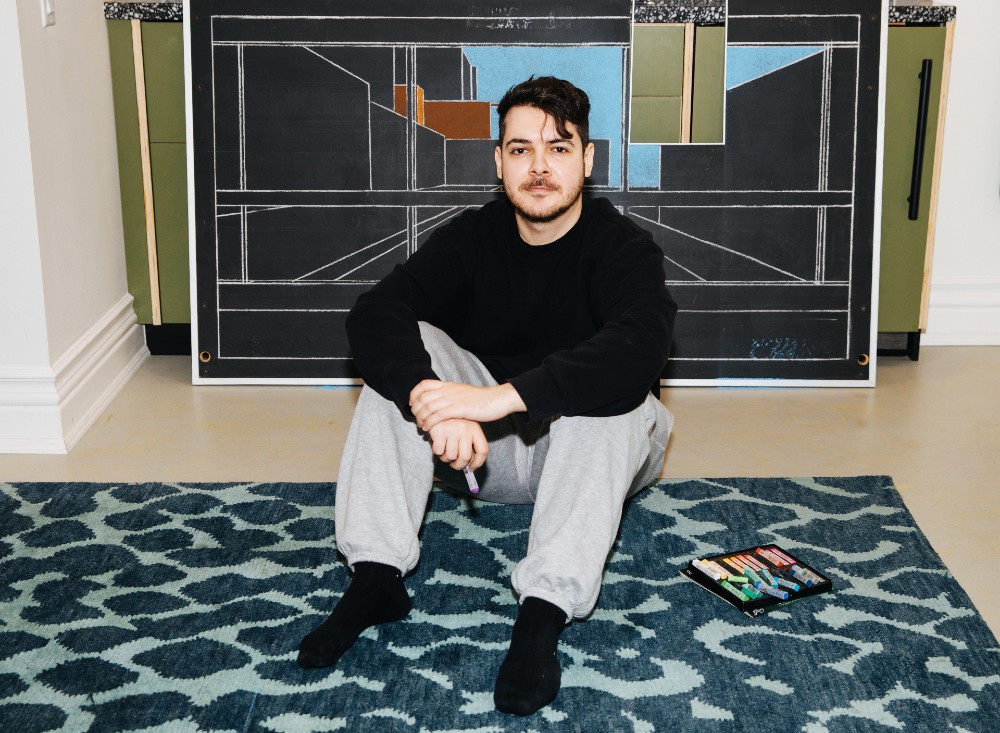For Brampton-based artist Diogo Pinheiro, the subway stations he frequented were more than just stops on the way during his commute—they’re a major source of artistic inspiration. Offering a unique perspective using colour and form, his work explores urban landscapes and how we move through them.
Recently Diogo was invited to live, work and create an original piece of art for us in The Artist Loft at The Drake Hotel. Displayed in our dining room lounge, Diogo’s final piece is a chalk illustration that depicts Toronto subway stations in a rare state—completely free of commuters. We caught up with Diogo to chat about what inspires him, his fascination with architecture, art, and more. You can also find him on Instagram here.
Tell us a bit about your path to becoming an artist.
At an early age, I started drawing on and off but never seriously enough to consider it long term or as a future career. I went through a lot of potential career ideas—from landscape architecture to working in politics in some form (thankfully, I didn’t go with politics). I knew I wanted creativity while leaving some sort of positive mark, but ultimately these different career paths seemed to lack this.
It wasn’t until my last year in my program at OCAD University that I got to create a body of work for the GradEx show. That’s when and where I figured out what I wanted to paint and dedicate my time exploring.
I think the hardest part about choosing art as a career is figuring out what you want to dedicate a significant portion of your time exploring and figuring out how you can do that while being able to pay for rent and food.
What is your main source of inspiration when creating your work?
In that last year at OCAD U, I had a realization that something about architecture attracted me. Throughout the years of drawing and painting, architecture was always what I ended up being pulled towards. The recipe of architecture from my artistic view is geometry, perspective and the addition of color, all in balance.
My specific use of public transit architecture comes from commuting five days a week between Brampton and Toronto, spending several hours each day at the stations people watching and exploring. I noticed how people were either looking at their phones or lost in thought—but never seemingly interested with their environment. I don’t blame them, considering that these stations weren’t created to be observed for long periods of time, like galleries or museums. Rather, these environments had a function to move people—quickly, efficiently.
Nonetheless, these environments were designed by architects who put in their own creativity to bring these places to life while keeping in mind their function, but that function ultimately causes that creativity to be overlooked. I also think public transit architecture is a great representation of why architecture in general is often overlooked in cities—they represent the same speed of life within a major city, always moving to the next destination with no time to stop.
Do you paint straight from photographs or do you edit the photo to pare it down first?
I paint from photographs of real locations, but the paintings are abstracted versions of the photographs. I reduce the details of the locations by emphasizing geometric shapes and the structures created by those shapes. I also remove distractions such as advertisements, lettering, and people because the architectural elements of these places are the main focus of the piece.
The color palettes are also limited, I leave the dominant colors so the locations are recognizable by the viewer, only abstracting the paintings to a point that they can still be recognized as distant memories. It’s quite fun seeing a person’s reaction going from “I think I know this place” to, “Wow, I used to or still take the subway at this station every day.”
What was the experience of working with chalk like?
It was interesting and fun, but the start was difficult because I haven’t used it as a medium. I had to figure out its limitations. I should have started by adding a bit of grit texture to the surface to get a more solid colour down. The chalkboard-like lack of texture made it slightly more difficult, but I am quite happy with the end result.
Tell us what your dream collaboration would be?
My dream collaboration would be with Edward Hopper. This is completely for selfish reasons—artists that were alive before the time where digital recording was widely available have a lot of early work missing. I think the early work shows the progress that an artist made before they became well known. So I would have the collaboration with Hopper purely so I could watch him paint and have conversations to learn from him.
Do you listen to anything while you work? If so, what do you tend to play?
My go-to music is Godspeed You! Black Emperor, a Montreal-based band. Although right now I’ve been listening to Hildur Guðnadóttir, a cellist and composer. Both set a certain mood between calmness and chaos which is basically my thought process—a long wake of organized chaos.
What are you most looking forward to in 2022?
I am looking forward to two exhibits and auctions I’m taking part in this year. I was invited back to the Kingsway-Lambton Art Show & Sale and Art Gems 2022 Emerging Artist Show. Both are charity events which I am very happy to be part of. Meanwhile, I have a few other show applications waiting for a response as of writing this (fingers crossed that I get in). As always, I’m looking forward to projects or shows that I have yet to discover or start.

